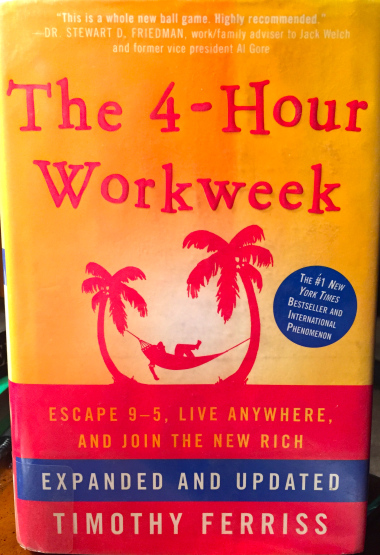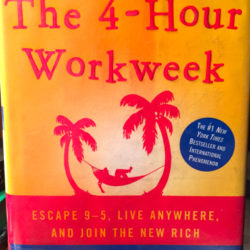Originally published August 2015
My dream job is one where I have the opportunity to travel. I am itching to explore the world, to experience different cultures, and to get paid to do so would make it that much better. When “The 4-Hour Workweek” by Timothy Ferriss was suggested to me, it seemed like it would be the an interesting book thanks to the life experiences of Ferriss alone, but with the sheer amount business advice sprinkled throughout, “The 4-Hour Workweek” flew right to the top of my list.
Ferriss seems to have done it all. He was a National Chinese kickboxing champion, the first American to hold a Guinness World Record in tango, and an MTV breakdancer in Taiwan, just to take three of the many interesting accomplishments mentioned at the beginning of his book. “The 4-Hour Workweek” promises to show readers how Ferriss was able to accomplish all that he has, as well as advise readers on how they too can live their dreams of working less and exploring the world more.

What I Liked
My absolute favorite part of “The 4-Hour Workweek” was the abundance of travel stories. Whether they were from Ferriss himself, describing his nervousness right before competing in the World Tango Championship in Buenos Aires, or one of his case studies, my favorite being Josh Steinitz observing ten narwhals surface in Baffin Island in Nunavut, the emphasis on aspiring to travel the world inspired me. Although it’s been roughly two months since I’ve come home from studying abroad, I still wish at times I were still exploring smaller sections of town in Barcelona or lounging around the lake in Annecy. Ferriss made me excited to travel more, and to start dreaming of places I would want to take a ‘mini-retirement’ to.
Trustworthy recommendations can be hard to come by. Thankfully, one of the best attributes of “The 4-Hour Workweek” was the sheer number of resources listed throughout the book. No matter what section, Ferriss was able to list pages of websites, books, etc. to help readers apply his tips and tricks. All of the resources are organized in the relevant chapter, and are further divided into subheadings. For example, doodle.com, a scheduling tool we use at NUMA, is at the end of the chapter titled “Interrupting Interruptions and the Art of Refusal,” and is then organized into the subheading “One Shot, One Kill Scheduling Without E-mail Back-and-Forth.” This makes finding exactly what resource is best for you easy, and also helps by clearly explaining what each resource entails.
The most thought provoking part of the book for me was the call to action Ferriss included titled “Find Yoda.” What Ferriss encourages readers to do is to call what he refers to as a ‘superstar mentor,’ aka any big named individual you have always wanted to talk to but never thought you could. The example Ferriss includes is John Grisham, but pretty much any celebrity or person you admire will do. He provides a script to reference, and also gives tips on how to go about contacting them. This to me is really intriguing. There are a ton of people I admire, and would love to speak to for five minutes, but I would never in the past even considered contacting them. Ironically I’m reading this book while having to do something similar for a club I’m involved with at school, the Emerging Markets Club. Recently I called Nathan Eagle, co-founder and CEO of Jana Mobile, and was able to speak with him for ten minutes about his business, and convinced him to come to speak to our club. After reading this, and having a success so far, I am excited to see who else I will be able to get into contact with!
Ferriss also discusses the idea that instead of ‘binge traveling,’ which as he describes it is when you “go nuts and see 10 countries in 14 days and end up a wreck,” you should rather aspire to go on ‘mini-retirements’ which instead consists of “relocating to one place for one to six months before going home or moving to another locale.” The idea is that instead of taking a break from your life, you instead modify it. This interests me due to the traveling aspect, and how he describes the differences between living in a new country versus merely visiting it. Ferriss also going into detail the finances of mini-retirements, and shows that while the idea initially seems as though it is going to be horrifyingly expensive, in actuality taking a mini-retirement could be beneficial to your wallet.
What I Didn’t Like
While there were many things I liked about “The 4-Hour Workweek,” there were also a multitude of things that I didn’t particularly enjoy. For starters, it seems unrealistic. I could just be old-fashioned, but the way I see it, Ferriss is suggesting that you create a business, preferably online, that essentially makes itself, so that you have an abundance of free time (only needing four hours a week to check in on it). While this would work for certain businesses, I feel as though not all entrepreneurs have ideas that would be easily applied to this model. In addition, there are tons of people that are not entrepreneurs, but like their job, and are not necessarily able to work remote and never come into the office. From my limited experience, I’ve seen that entrepreneurial ventures take a lot of blood, sweat, and tears, and saying that you can run a successful business to fund an life filled with exotic travels and adventures within a month seems a bit farfetched.
At times I also felt as though Ferriss was advocating dishonesty to get ahead. While nothing he suggests is anything but legal, I believe I personally would feel uneasy using his methods. The biggest issue I had was when he was describing how to become an expert in anything in four weeks. He starts by describing the difference between “being perceived as an expert and being one.” Some tricks include joining trade organizations with “official sounding names,” reading three books on the subject matter, and joining ProfNet, a website that helps journalists find quotes for articles. While I am interested in inbound marketing, where the idea is to set yourself up as an expert in your field, I feel as though Ferriss is detailing how to be perceived as an expert without actually knowing anything. I do realize the importance of being seen as an influencer, but I believe that you should actually have the knowledge to back your claims up.
Step III of the book is titled “A for Automation,” and has sections dedicated to how you can outsource your life. Ferriss highly recommends purchasing the services of a virtual assistant, essentially someone overseas who is willing to do tasks you don’t want to do. While I am able to see the benefits of having a virtual assistant, such as having someone research something you otherwise wouldn’t have time to do, or wouldn’t be able to do as well, Ferriss takes it to extremes. Ferriss’s prime example for having a virtual assistant, AJ Jacobs, goes so far as to have his virtual assistant email an apology to his wife for him. I understand the want for an assistant, but I truly believe Ferriss’s suggestion goes a little too far to the point it’s downright creepy. I’m convinced that having an assistant deal with my interpersonal relationships would hurt me in the long run, as I would lack the same skills when I didn’t have the assistant to fall back on.
Another issue I had potentially is a result of me reading “Never Eat Alone” earlier this summer. “Never Eat Alone” by Keith Ferrazzi talks about the importance of connecting with people, and how the relationships you build will help you succeed in business while also fulfilling you. I loved “Never Eat Alone” and Ferrazzi’s advice, and because of this I felt as though “The 4-Hour Workweek” and Ferriss were missing the importance of connections. Ferriss talks about how he believes it is best to pretend to be busy when someone wants to talk to avoid talking to someone for too long, and gives advice for how to avoid meetings, as well as having to talk to people for more than five minutes. This is all well and good for when you have a million and ten things that need to get done, but overall I find this advise to be terrible. While I understand that taking time out of your day can be frustrating, and explaining things more than once can be annoying, part of being human is forming connections with other people. Ferriss seems to forget that while creating a business and then leaving to travel is amazing, what’s also great is having a network of people you can go to for advice, forming relationships with people in a work setting, and being there for people when they too need help. Ferriss is very individualistic, but I believe it is to a fault.
The final thing that bothered me in “The 4-Hour Workweek” is more of a personal annoyance: Ferriss says repeatedly not to read too much. Neglecting the fact that he is saying it in his book, Ferriss overall seems to believe that reading is just a time waste, and that you should be doing better, more interesting things with your time. I could not disagree more. Reading not only improves your intelligence, it has been shown to promote empathy, as well as delaying diseases such as Alzheimer’s. Not to mention that reading is fun. While I appreciate the exuberance for travel Ferriss demonstrates, I feel as though he is missing the beauty that comes from reading a book and feeling as though you have traveled throughout the world and time without ever leaving your couch.
The Verdict
While “The 4-Hour Workweek” did have parts that I enjoyed, overall it just wasn’t to my liking. If I had a friend interested in entrepreneurship I would consider recommending it, but otherwise I would pass on suggesting this book to others.
For More On “The 4-Hour Workweek” and Timothy Ferriss
Website: http://fourhourworkweek.com
Blog: http://fourhourworkweek.com/blog/
Twitter: https://twitter.com/tferriss

Comments are closed